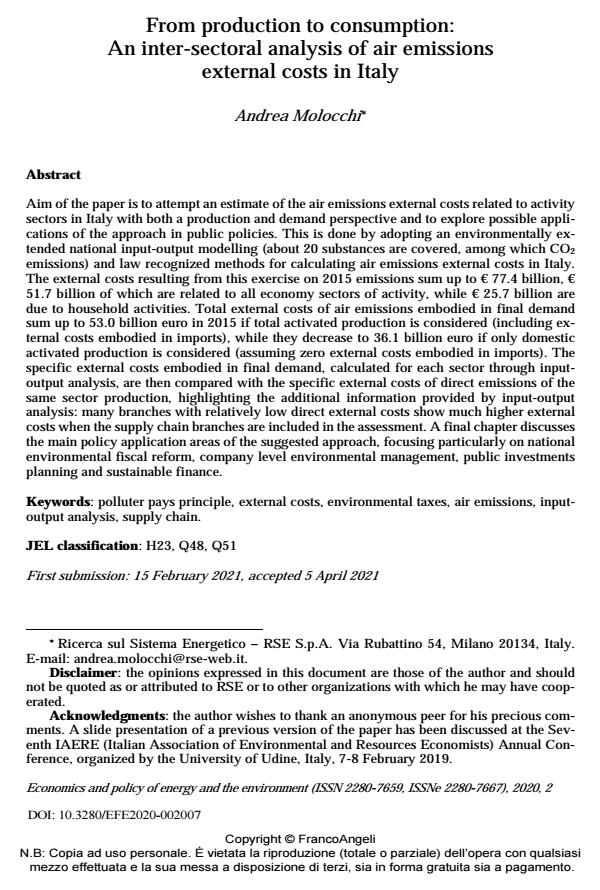From production to consumption: An inter-sectoral analysis of air emissions external costs in Italy
Journal title ECONOMICS AND POLICY OF ENERGY AND THE ENVIRONMENT
Author/s Andrea Molocchi
Publishing Year 2021 Issue 2020/2
Language English Pages 26 P. 155-180 File size 590 KB
DOI 10.3280/EFE2020-002007
DOI is like a bar code for intellectual property: to have more infomation
click here
Below, you can see the article first page
If you want to buy this article in PDF format, you can do it, following the instructions to buy download credits

FrancoAngeli is member of Publishers International Linking Association, Inc (PILA), a not-for-profit association which run the CrossRef service enabling links to and from online scholarly content.
Aim of the paper is to attempt an estimate of the air emissions external costs related to activity sectors in Italy with both a production and demand perspective and to explore possible appli-cations of the approach in public policies. This is done by adopting an environmentally ex-tended national input-output modelling (about 20 substances are covered, among which CO2 emissions) and law recognized methods for calculating air emissions external costs in Italy. The external costs resulting from this exercise on 2015 emissions sum up to € 77.4 billion, € 51.7 billion of which are related to all economy sectors of activity, while € 25.7 billion are due to household activities. Total external costs of air emissions embodied in final demand sum up to 53.0 billion euro in 2015 if total activated production is considered (including external costs embodied in imports), while they decrease to 36.1 billion euro if only domestic activated pro-duction is considered (assuming zero external costs embodied in imports). The specific exter-nal costs embodied in final demand, calculated for each sector through input-output analysis, are then compared with the specific external costs of direct emissions of the same sector pro-duction, highlighting the additional information provided by input-output analysis: many branches with relatively low direct external costs show much higher external costs when the supply chain branches are included in the assessment. A final chapter discusses the main poli-cy application areas of the suggested approach, focusing particularly on national environmental fiscal reform, company level environmental management, public investments planning and sustainable finance.
Keywords: Polluter pays principle, external costs, environmental taxes, air emissions, inputoutput analysis, supply chain.
Jel codes: H23, Q48, Q51
- The 9th International Conference on Energy and Environment Research Benedetta Marmiroli, Maria Leonor Carvalho, Giulio Mela, Andrea Molocchi, Pierpaolo Girardi, pp.203 (ISBN:978-3-031-43558-4)
Andrea Molocchi, From production to consumption: An inter-sectoral analysis of air emissions external costs in Italy in "ECONOMICS AND POLICY OF ENERGY AND THE ENVIRONMENT" 2/2020, pp 155-180, DOI: 10.3280/EFE2020-002007